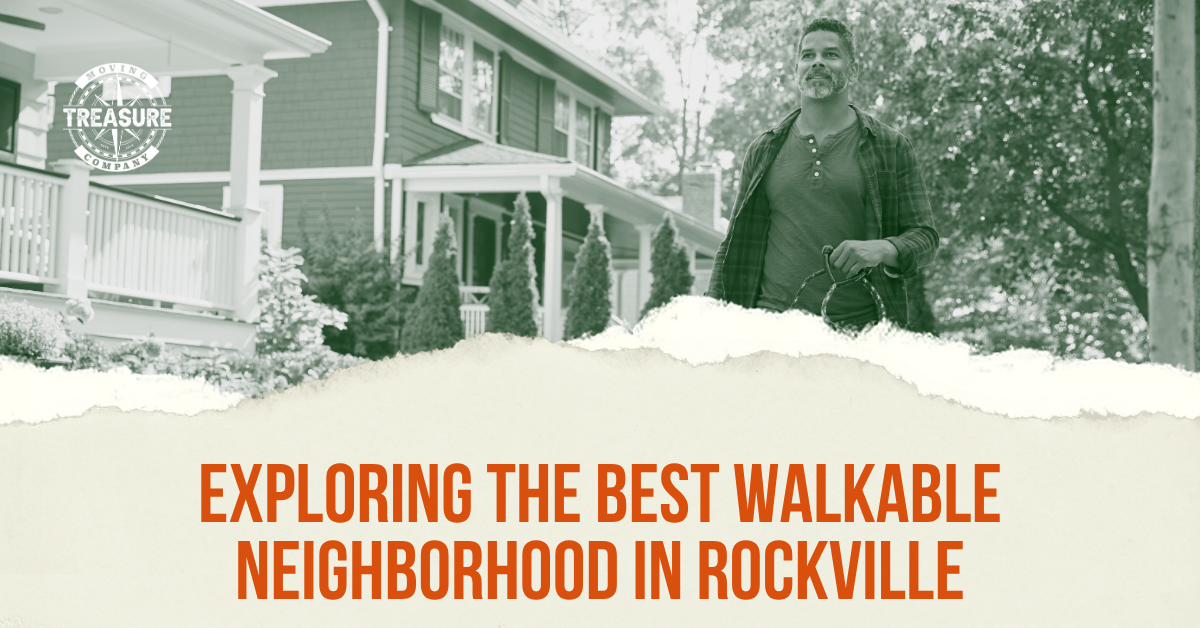
The best walkable neighborhood in Rockville is Rockville Town Center, now rebranded as The Square, where daily errands, dining, and entertainment sit within easy walking distance. Fallsgrove follows closely with its mixed-use village design and over 80 acres of green space connected by sidewalks. King Farm and Twinbrook round out the top walkable areas, each offering pedestrian-friendly design with strong transit connections to Metro stations.
Walkability transforms daily life in ways most people underestimate initially. Running errands on foot eliminates parking hassles and sitting in traffic. Walking to restaurants means no designated driver concerns or ride-share costs. Exercise happens naturally through daily activities rather than requiring gym trips. These benefits explain why walkable neighborhoods command premium prices despite smaller lot sizes.
Understanding Rockville, MD Walkability
Rockville, MD walkability has improved dramatically over recent years through intentional planning. The city adopted a Pedestrian Master Plan guiding infrastructure development systematically. Vision Zero projects enhance safety for pedestrians and cyclists throughout town. These initiatives demonstrate commitment to walkability beyond just developer efforts in individual neighborhoods.
Transit access amplifies walkability benefits significantly for commuters and residents. Metro Red Line stations at Rockville, Twinbrook, and Shady Grove connect the city. Bus routes operated by RideOn serve neighborhoods without direct Metro access. This multi-modal transportation network allows reducing car dependency substantially for many households.
The combination of pedestrian infrastructure and transit creates genuine car-optional living. Residents can walk for daily needs and take transit for longer trips. This lifestyle reduces transportation costs by thousands annually compared to car ownership. Environmental benefits matter increasingly to buyers prioritizing sustainability in location decisions.
City-Wide Pedestrian Improvements
Rockville invests actively in walkability across all neighborhoods, not just downtown. Sidewalk construction fills gaps in pedestrian networks systematically over time. Crosswalk enhancements improve safety at busy intersections through better visibility. Road reconfigurations slow traffic and prioritize pedestrian safety in key areas.
Vision Zero initiatives target eliminating pedestrian fatalities and serious injuries completely. Multiple projects focus on Town Center where foot traffic concentrates most. Protected bike lanes separate cyclists from vehicle traffic on major routes. These improvements make walking and biking feel safer, encouraging more residents to try car-free trips.
The Pedestrian Master Plan guides development decisions with walkability as priority. New construction must include sidewalks connecting to existing networks properly. Developers cannot create isolated subdivisions accessible only by car anymore. This policy ensures future Rockville becomes more walkable rather than less over time. For comprehensive city information, explore this detailed Rockville city guide.
Most Walkable Neighborhoods in Rockville Ranked
Creating a definitive list of most walkable neighborhoods in Rockville requires examining multiple factors. Proximity to daily needs matters most for practical walkability assessment. Sidewalk quality and connectivity determine whether walking feels pleasant or frustrating. Safety from traffic allows comfortable walking at all hours and ages.
Rockville Town Center: The Square
Rockville Town Center, rebranded as The Square, claims the title of best walkable neighborhood in Rockville convincingly. This urban hub concentrates shops, restaurants, and entertainment within compact area. Daily errands happen entirely on foot for residents living in or near downtown. The density creates vibrant street life unusual in suburban contexts.
Recent revitalization brings new energy to this already walkable core consistently. Trader Joe's opened in summer 2025, eliminating grocery shopping as car-dependent errand. Restaurants like Kusshi Sushi and Little Miner Taco add dining variety within walking distance. Fork & Kitchen will soon open, further enhancing the food scene. These additions make car-free living increasingly practical and enjoyable.
The Rockville Metro station sits at the heart of Town Center accessibility. Commuters reach downtown Washington in under 30 minutes via Red Line. This transit connection allows true car-free living for those working in the city. The station also provides access to entire Metro system for weekend activities and entertainment throughout region.
Nightlife and entertainment options concentrate here more than any other Rockville area. Restaurants stay open late serving dinner crowds and bar patrons. The Music Center at Strathmore hosts performances attracting audiences regionally. Community events activate public spaces regularly throughout the year. This after-dark activity makes evening walks feel safe and interesting.
Housing options in Town Center range from apartments to condos and some townhomes. Rental apartments provide most accessible entry into this walkable lifestyle quickly. Condos offer ownership without single-family maintenance responsibilities and costs. Townhomes exist for those wanting more space while maintaining walkable location. Prices reflect the premium walkability commands in real estate markets.
Fallsgrove: Village Living by Design
Fallsgrove showcases master-planned community design executed with walkability as priority. The mixed-use village center places groceries, dining, and services within easy walking distance from homes. Over 80 acres of green space connects through sidewalks and paths for recreation. This combination creates self-contained community where cars become optional for daily life.
Village atmosphere emerges from thoughtful planning rather than just high density alone. Architecture varies enough to avoid cookie-cutter appearance while maintaining cohesion. Street trees and landscaping make walking pleasant even in summer heat. Public spaces provide gathering spots that encourage lingering rather than just passing through quickly.
Walkability for daily needs reaches very high levels throughout this neighborhood consistently. Residents walk to Fallsgrove Village Center for grocery shopping at multiple options. Restaurants and cafes provide dining choices without driving anywhere at all. Services like dry cleaning and hair salons operate within the village center. Medical offices handle routine healthcare needs locally as well.
Parks and recreation access happens entirely on foot through connected path systems. Playgrounds serve different age groups across the community's 80-plus acres. Walking trails provide exercise routes through natural areas and developed sections. Sports fields accommodate organized activities and casual play equally well. This green space makes outdoor activity habitual rather than requiring special trips.
Transit connections serve Fallsgrove through RideOn bus routes reliably on schedule. These buses connect to Rockville and Shady Grove Metro stations efficiently. While not directly on Metro like some neighborhoods, good bus service reduces car dependency substantially. The combination of walkable daily needs and transit access creates genuinely car-optional lifestyle. For detailed neighborhood comparisons, check this comprehensive neighborhoods guide.
King Farm: Traditional Neighborhood Design
King Farm demonstrates how traditional neighborhood design creates walkability without urban density. The community features mix of housing types from apartments to single-family homes. Shops and restaurants integrate into residential fabric rather than segregating into separate zones. Parks and outdoor spaces connect through sidewalk networks throughout the entire development.
Pedestrian infrastructure gets designed intentionally rather than added as afterthought to car-oriented plans. Sidewalks line all streets connecting homes to destinations directly and safely. Street widths stay narrow enough to slow traffic and make crossing comfortable. Trees provide shade making summer walking pleasant rather than punishing experience.
Daily amenities sit within comfortable walking distance for most King Farm residents. Shopping includes both daily necessities and occasional purchases conveniently located. Dining options range from casual to upscale within the neighborhood boundaries. Parks provide recreation without driving to county facilities elsewhere in region. This completeness reduces car trips significantly for many households.
The Shady Grove Metro station sits conveniently near King Farm's boundaries accessibly. Walking distance varies depending on specific location within this large community. Some residents walk to Metro regularly while others drive and park. Bus routes also serve the area for those farther from the station. This transit access allows car-free commuting for those prioritizing that lifestyle.
Community atmosphere benefits from walkability encouraging casual neighbor interactions regularly. Parents walking children to school encounter other families building relationships. Evening strolls lead to spontaneous conversations on sidewalks and at parks. This social connection develops more naturally in walkable neighborhoods than car-dependent suburbs. The result strengthens community bonds beyond just housing location. For family considerations, see this family neighborhoods guide.
Twinbrook: Affordable Walkability with Metro Access
Twinbrook offers the most affordable entry into walkable, transit-connected living in Rockville. The Twinbrook Metro station provides direct access to downtown Washington efficiently. This connection allows truly car-free commuting for substantial cost savings annually. Housing costs run well below other Metro-accessible neighborhoods creating exceptional value.
Walkability for daily needs exists though not as comprehensively as Fallsgrove or King Farm. Commercial areas near the Metro station include restaurants and services within walking distance. Rock Creek Park sections provide green space and trails for recreation close by. Grocery shopping requires either longer walks or short drives for most residents currently.
The neighborhood mix includes apartments, townhomes, and single-family homes at various price points. This variety creates economic diversity unusual in more expensive walkable neighborhoods elsewhere. Young professionals find affordable apartments near Metro stations for easy commutes. Families can buy starter homes while maintaining transit access and some walkability.
Area improvements gradually enhance Twinbrook's walkability and appeal over time consistently. New businesses open as demographics shift with younger residents moving in. Property renovations improve housing stock without displacing long-term residents yet. Infrastructure investments make walking safer and more pleasant than previous years. Early buyers benefit most from these improvements through property appreciation.
Transit orientation makes this neighborhood particularly valuable despite less complete walkability currently. Car-free commuting saves substantially more than walking to groceries saves typically. Metro access also enables car-free weekend activities throughout the DMV region easily. This lifestyle matters increasingly to younger buyers prioritizing sustainability and urban connection. For young professional insights, explore this young professional areas guide.
Do You Need a Car in Rockville, MD?
Do you need a car in Rockville, MD? The answer depends heavily on where you live and work specifically. Residents in Town Center, Fallsgrove, or King Farm near Metro can live car-free successfully. Those in less walkable neighborhoods or with jobs outside Metro corridors find cars necessary practically.
Car-Free Living Considerations
Living without a car requires walkable daily needs plus good transit for other trips. Groceries must sit within comfortable walking distance or reachable by transit easily. Healthcare providers need accessibility via walking or public transportation reliably. Employment location determines whether car-free commuting works practically long-term.
The best walkable neighborhood in Rockville for car-free living is definitely Town Center. Everything needed daily sits within half-mile radius or less from most downtown residences. Metro station access enables commuting and weekend activities throughout the region. Delivery services supplement walking for bulky items or bad weather situations.
Fallsgrove and King Farm allow car-free living with some compromises accepted willingly. Daily needs get met on foot within the neighborhoods successfully and conveniently. Transit to Metro stations requires bus rides adding time to commutes somewhat. Medical appointments or shopping outside the neighborhood requires planning and extra time.
Twinbrook works for car-free living focused on commuting primarily over daily errands. Metro access makes work trips easy without owning vehicles at all. Daily errands require more effort with longer walks or bus connections. Grocery delivery services help supplement what's not walkable easily from home.
Car-Lite Living as Middle Ground
Many Rockville residents adopt car-lite lifestyles reducing but not eliminating vehicle use. One car serves a two-adult household instead of two vehicles owned. Walking and transit cover most trips with car reserved for specific needs. This approach saves substantially on insurance, parking, maintenance, and depreciation costs.
Car-sharing services like Zipcar operate in Rockville for occasional vehicle needs efficiently. Hourly rentals cost less than car ownership for infrequent use patterns. Vehicles available nearby eliminate need for personal parking and maintenance. This option works particularly well for those living in walkable areas near Town Center.
Bike infrastructure continues improving throughout Rockville's most walkable neighborhoods consistently. Protected bike lanes separate cyclists from traffic on major routes safely. Bike-share programs may expand in future adding options for short trips. E-bikes extend practical biking range making more destinations accessible without cars. This expands car-free living possibilities beyond just walking distance limits.
Weather affects car-free living feasibility in Maryland's climate with distinct seasons. Summer heat makes walking less pleasant though not impossible with preparation. Winter snow and ice create legitimate safety concerns for pedestrians temporarily. Rain makes walking uncomfortable without proper gear though buses continue operating. These seasonal challenges require flexibility and planning for car-free households.
Benefits of Walkable Neighborhood Living
Choosing the best walkable neighborhood in Rockville delivers benefits beyond just transportation savings. Health improves through daily walking incorporated naturally into routines automatically. Social connections develop more easily through regular neighborhood encounters on sidewalks. Environmental impact decreases substantially with reduced driving for daily needs.
Financial Advantages
Transportation costs rank second only to housing in most household budgets nationally. Car ownership costs average $10,000 annually including depreciation, insurance, gas, and maintenance. Eliminating one vehicle from a two-car household saves substantially over time. Walking replaces gym memberships for many people providing fitness without additional expense.
Housing costs more in walkable neighborhoods but transportation savings offset differences partially. The premium for walkable location varies but typically adds 10-20% to purchase prices. Monthly savings from reduced car dependency can exceed $800 for households eliminating vehicles. Over 30-year mortgage terms, the math often favors walkable locations despite higher purchase prices.
Time savings compound financial benefits in ways people often overlook initially. Parking hassles disappear when walking to destinations directly from home. Traffic stress elimination improves quality of life measurably for commuters. Exercise happens naturally without requiring separate gym trips and time commitments. These lifestyle improvements have real value beyond just dollar amounts.
Health and Lifestyle Benefits
Daily walking incorporated naturally into errands provides consistent physical activity effortlessly. This matters more than intense occasional workouts for long-term health outcomes. Cardiovascular health improves from regular walking at moderate pace consistently. Weight management becomes easier with daily activity rather than sedentary car-dependent lifestyle.
Mental health benefits from walking include stress reduction and improved mood measurably. Nature exposure during park walks provides additional psychological benefits beyond exercise. Social interactions during neighborhood walks reduce isolation and loneliness significantly. These factors contribute to overall wellbeing that healthcare costs cannot capture.
Community connection develops more naturally in walkable neighborhoods through repeated encounters. Parents walking children to school meet other families building relationships naturally. Evening strolls lead to conversations with neighbors on sidewalks regularly. Local businesses become familiar rather than just anonymous shopping destinations. This social fabric creates belonging that isolated car-dependent suburbs cannot replicate.
Making Your Walkable Neighborhood Choice
Selecting the best walkable neighborhood in Rockville for your situation requires honest assessment. Daily routine determines which amenities must sit within walking distance practically. Commute requirements influence whether Metro access becomes essential or just nice to have. Budget constraints eliminate some walkable neighborhoods from consideration immediately regardless of preference.
Visit neighborhoods on foot at different times before making decisions about location. Morning walks reveal commute patterns and foot traffic levels accurately during rush hours. Afternoon exploration shows how families use parks and sidewalks for recreation and socializing. Evening assessment indicates whether areas feel safe and welcoming during darker hours. These observations ground decisions in reality rather than just marketing descriptions.
Test your actual daily routine in potential neighborhoods before committing to purchases. Walk to where you would grocery shop carrying typical bag loads home. Time the walk to Metro station during commute hours with realistic pace. Try reaching doctor offices, pharmacies, and other services on foot. These experiments reveal whether car-free living actually works for you specifically.
Consider future life changes that might affect walkability needs over time realistically. Young children make walking errands more challenging temporarily with strollers and naps. Teenagers need different amenities within walking distance than young adults or retirees. Aging may eventually make some walks difficult requiring reconsideration of car dependency. Choose neighborhoods that accommodate likely changes over your expected stay duration.
The most walkable neighborhoods in Rockville offer lifestyles increasingly valued by modern buyers. Town Center provides urban density with suburban safety and good schools nearby. Fallsgrove delivers village atmosphere through master-planned design executed skillfully.
King Farm combines traditional neighborhood character with contemporary walkability deliberately. Twinbrook offers affordable access to transit-oriented living and Metro connections. Each serves different needs successfully, making Rockville an excellent choice for anyone prioritizing walkability and reduced car dependency in the DMV region.

